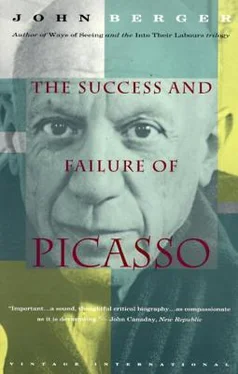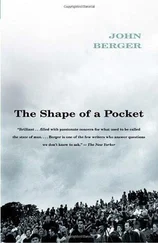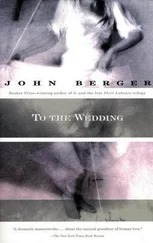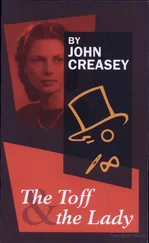To fill the vacuum left by reality, it is necessary to invent. His life is full of fantasies and specially created dramas. I do not speak of his subjective life, but the daily life in his household. There are invented characters, invented rituals, invented turns of phrase. Nothing, as it were, remains standing on the floor. Everything is lifted up and made ‘truer than life’ by his devotees, so that he shall never feel lost in emptiness. One is reminded of the last days of some old vaudeville star: everything, creaking now, is still invented as superlative. But there is one great difference: old vaudeville players go on performing till they drop. The tinsel is to keep them going, not to distract them.
So complete is the loss of reality and so frenetic are the efforts of all those around him to keep him feeling and being great that Picasso himself is no longer believed. A man who has trusted his own sensations as he has done knows the extent to which things have gone. He is desperate. The last thing he says in Parmelin’s book is: ‘You live a poet’s life and I a convict’s.’ But she, in her usual state of euphoria induced by believing that she is the great man’s confidante, thinks that this is just Picasso being Picasso.
At this point I may be accused of being too imaginative. I talk of pictures that Picasso might have painted in India. I describe to you Picasso’s inner state of mind without having met him and in the face of the evidence of those who write about him as friends. My justification is that what I have deduced is the result of trying to relate all the facts that can be publicly known about Picasso. So often important ones are hidden or ignored.
Painters, unlike a certain kind of poet, need time to develop and slowly uncover their genius. There is not, I think, a single example of a great painter — or sculptor — whose work has not gained in profundity and originality as he grew older. Bellini, Michelangelo, Titian, Tintoretto, Poussin, Rembrandt, Goya, Turner, Degas, Cézanne, Monet, Matisse, Braque, all produced some of their very-greatest works when they were over sixty-five. It is as though a lifetime is needed to master the medium, and only when that mastery has been achieved can an artist be simply himself, revealing the true nature of his imagination.
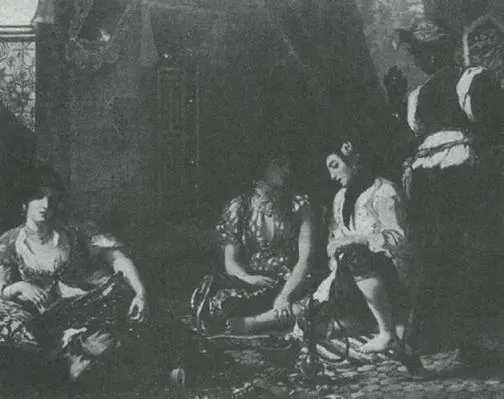
102 Delacroix. Les Femmes d’Alger. 1834
However favourably one judges Picasso’s work since 1945 it cannot be said to show any advance on what he created before. To me it represents a decline: a retreat, as I have tried to show, into an idealized and sentimental pantheism. But even if this judgement is mistaken, the extraordinary fact remains that the majority of Picasso’s important late works are variations on themes borrowed from other painters. However interesting they may be, they are no more than exercises in painting — such as one might expect a serious young man to carry out, but not an old man who has gained the freedom to be himself.
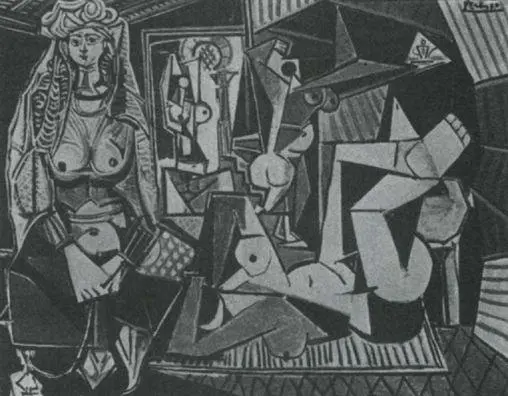
103 Picasso. Les Femmes d’Alger. 1955
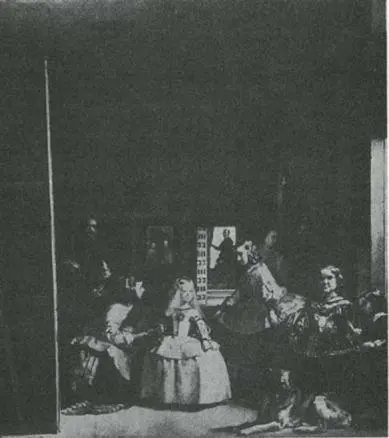
104 Velazquez. Las Meninas. 1956
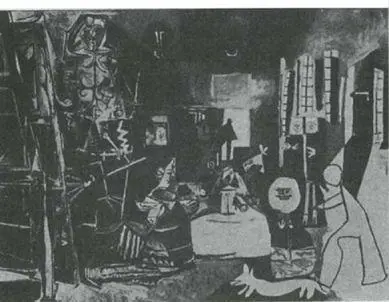
105 Picasso. Las Meninas. 1957
It is sometimes claimed that Picasso only takes Delacroix or Velazquez as a starting point. In formal terms this is true, for Picasso often reconstructs the whole picture. But in terms of content the original painting is even less than a starting point. Picasso empties it of its own content, and then is unable to find any of his own. It remains a technical exercise. If there is any fury or passion implied at all, it is that of the artist condemned to paint with nothing to say.
Notice in his variation on the Velazquez how extreme the distortions and displacements are. The dwarf, the dog, the painter are wrenched out of Velazquez’s hands — but for what reason, to express what? One has only to compare any of these figures with the Bullfight , painted twenty years before, to be reminded of how intensely Picasso once used distortions to communicate experience.
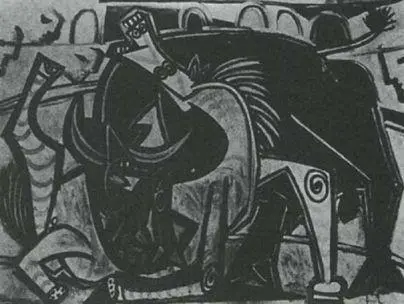
106 Picasso. Bullfight. 1934
The violence, it seems, is only to rob Velazquez: to honour him perhaps at the same time as robbing him; even — and again like a child — thus to ask for his protection. In his own painting Velazquez is so effortlessly himself, and in Picasso’s painting he is so overwhelmingly large, that he might be a father. It may be that as an old man Picasso here returns as a prodigal to give back the palette and brushes he had acquired too easily at the age of fourteen. Perhaps this last large painting of Picasso’s is a comprehensive admission of failure. Perhaps this is only a minute part of the truth, or none of it at all. But what is certain is that neither Picasso’s Las Meninas nor any of his late paintings are the mature work of an old painter, at last able to be himself. What is certain is that Picasso is a startling exception to the rule about old painters.
Why has nobody pointed this out? Why has nobody considered Picasso’s likely desperation? Apparently it is not only in his own household that nobody dares to mention the word failure. Apparently we need to believe in Picasso’s success more than he does himself.
Towards the end of 1953 Picasso began a series of drawings. At the end of two months there were 180 of them. Drawn with great intensity, they are autobiographical; they are about Picasso’s own fate.
When they were first exhibited and published, their general character was recognized. Besides praising the ‘exquisite use of line’, people talked of an ‘emotional disturbance’, etc. But then, in order not to understand what the drawings confessed , everyone pretended that their meaning was so complex and mysterious and personal that it would be impertinent to try to put it into words. Enough to declaim once more: Picasso! And after having admired the brilliance, to forget everything but his ‘greatness’. (The greatness that had ground him to a standstill.)
It is true of course that for Picasso each of the drawings must have had several levels of meaning and hundreds of stray associations. But it is equally true that the theme of the confession as a whole is quite unambiguous.
In nearly every drawing there is a young woman. Not necessarily the same one. Usually she is naked. Always she is desirable. Sometimes she is being painted. But when this happens, one scarcely feels that she is posing. She is there — just as she is there in the other drawings; her function is to be. She is nature and sex. She is life. And if that sounds a little ponderous, remember that it is for the same elemental reason that all drawing classes from the nude model in all art schools are called Life Classes.
Beside her Picasso is old, ugly, small, and — above all — absurd. She looks at him not unkindly, but with an effort — as though her concerns were so different from his that he is almost incredible to her.
He struts around like a vaudeville comedian. (The comparison I made a few pages back is one that has occurred to Picasso too.) She waits for him to stop.
Читать дальше
